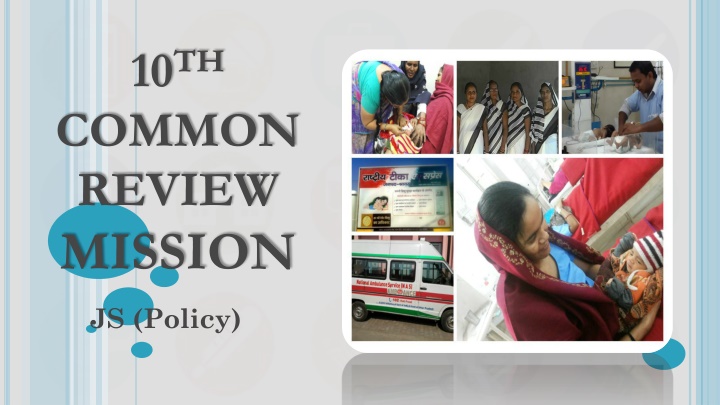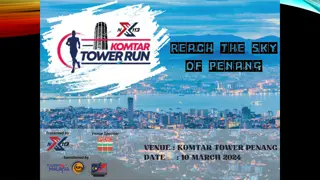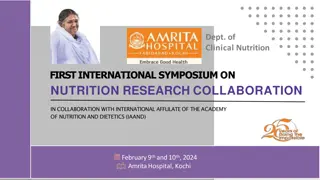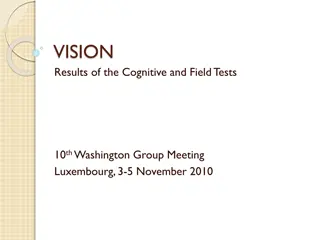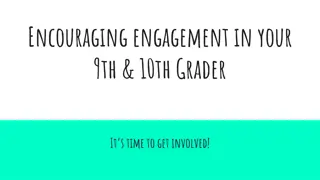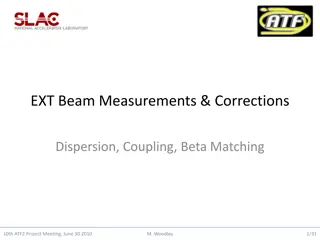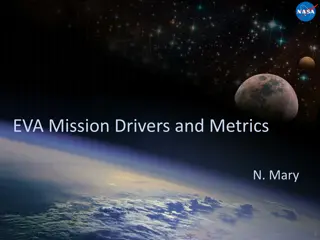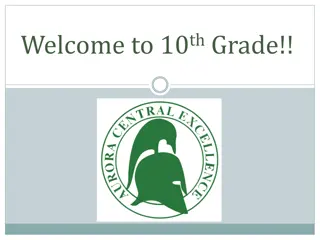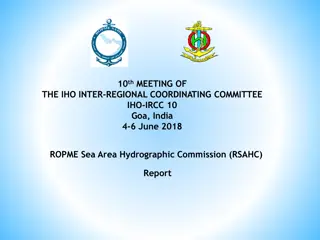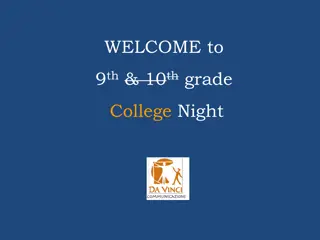Summary of 10TH COMMON REVIEW MISSION JS (Policy)
The 10th Common Review Mission JS (Policy) took place from Nov 4th to 11th, 2016, covering a total of 16 states including high-focus states. Key areas of focus included service delivery, reaching the unreached, disease control programs, healthcare financing, governance, and more. The mission highlighted encouraging findings such as the NHM Free Drugs Services Initiative, while also identifying areas of concern like limited functionality of certain healthcare services and facilities.
Download Presentation

Please find below an Image/Link to download the presentation.
The content on the website is provided AS IS for your information and personal use only. It may not be sold, licensed, or shared on other websites without obtaining consent from the author.If you encounter any issues during the download, it is possible that the publisher has removed the file from their server.
You are allowed to download the files provided on this website for personal or commercial use, subject to the condition that they are used lawfully. All files are the property of their respective owners.
The content on the website is provided AS IS for your information and personal use only. It may not be sold, licensed, or shared on other websites without obtaining consent from the author.
E N D
Presentation Transcript
10TH COMMON REVIEW MISSION JS (Policy)
BACKGROUND - Nov 4th -11th , 2016 - Covered a total of 16 states 8 High Focus States including three North- Eastern States, six Non High Focus States and 2 UTs. A total of members including Officials from NITI Aayog, MOHFW and other related departments, Public Health Experts, Civil members, Partners representatives and MoHFW Consultants. about 300 GoI Society Development
Terms of Reference Service Delivery : Reaching the Unreached RMNCH+A Communicable Disease Control Programmes Non- communicable Disease Control Programmes HRH and Training Community Processes and Convergence Information and Knowledge Healthcare Financing Quality Assurance 10. National Urban Health Mission 11. Governance and Management 1. 2. 3. 4. 5. 6. 7. 8. 9.
TOR 1 : SERVICE DELIVERY- ENCOURAGING FINDINGS NHM Free Drugs Services Initiative taking route across the country All CRM States have notified Free Drug Policy, Out of Pocket Expenditure (OOPE) on drugs declined IT based drug distribution system adopted in all CRM States(except Arunachal Pradesh, Nagaland and Chandigarh) Call centers linked ambulance services established in all CRM States (except Jharkhand, Kerala, Tripura and Nagaland) NHM Free Diagnostic Services Programme implemented in several States including Andhra Pradesh, Gujarat, MP etc improving footfalls Biomedical Equipment Maintenance Program (BMMP) has improved functionality of equipments and helped in assured diagnostics services, BMMP implemented in 7 out of 16 CRM states.
TOR 1 SERVICE DELIVERY AREAS OF CONCERN DVDMS functionality upto PHC level yet to be operationalized in many States. Integration of National drug supplies and stock outs still an area of concern. Quality Assurance, Prescription audits and STGs are yet to be institutionalized in some CRM States. Free Diagnostics Services Initiative not yet implemented in J&K, Bihar, Arunachal Pradesh, Tripura Significant shortfall in number of health facilities (CHCs, PHCs, SHCs) in Bihar, UP and Nagaland etc MMUs under-utilized (e.g. Arunachal Pradesh, Bihar, J&K) and not operationalized in UP.
TOR 1 SERVICE DELIVERY AREAS OF CONCERN Limited functioning of Blood Storage Units due to non-linkage with a mother Blood Bank (Nagaland, Gujarat, Arunachal Pradesh, UP, J&K and Bihar) Barring Tamil Nadu, reports indicate some form of out of pocket expenditure on blood services, transportation and drugs (The cost incurred towards blood services ranged from Rs 300 to Rs 3000). Infrastructure completion rate poor in some States. eg Jharkhand, Bihar, UP.
TOR 1 SERVICE DELIVERY RECOMMENDATIONS Prioritizing DH with at least 8 core specialties, follow GOI guidelines on DH strengthening Appraising & building the capacities of EMTs for ensuring quality emergency care, expanding Call Centre based integrated patient transport n/w (only patient transport vehicle, BLS & ALS) in ALL states on Time to Care norm (less than 1/2 hr even in rural areas) Strengthen emergency services at District Hospitals Setting up dedicated professional cell within the ambit of SPMUs to guide and monitor PPP mechanisms/ agreements. Operationalize IT backed DVDMS upto PHC level to avoid stock-outs & wastages, along with mechanism of quality assurance, prescription audit. Bringing the hospital infrastructure related HR under the administrative control of health department to expedite completion.
TOR 1 SERVICE DELIVERY RECOMMENDATIONS CONTD Operationalize NHM Free Drugs & Free Diagnostic Services and BMMP programme in all States. Improve access to 24*7 PHCs and fully functional CHCs based on population and Time to Care norm Implement eRaktKosh for managing operations of blood banks
TOR 2 : RMNCH +A- Encouraging Findings Routine Immunization (RI) services improving across all States, with increase in use of IT enabled platforms such as eVIN, ANMOL (Andhra Pradesh) etc. Prime Minister Surakshit Matritva Abhiyan (PMSMA) activities initiated in all States (except Bihar and Nagaland). Good mechanism of maternal death review (MDR) observed in TN, Maharashtra, Chandigarh and Gujarat, Tamil Nadu in process of establishing even Maternal Near Miss Review. Adequate supplies of ORS and Zn found in all States (except Arunachal Pradesh) Good planning and organization of VHND sessionsreported in Chandigarh, Maharashtra, Gujarat and Jharkhand.
TOR 2: RMNCH +A-AREAS OF CONCERN Quality of ANC particularly at the level of SCs deficient in terms of: Range of services (e.g. Tripura, Nagaland, Kerala, Chandigarh, Jharkhand) Line listing of high risk pregnancies (e.g. Nagaland, Delhi, Tripura, Uttar Pradesh, Himachal Pradesh, Bihar, Arunachal Pradesh) Orientation on newer guidelines -Gestational Diabetes Management, Calcium supplementation, etc (e.g. Andhra Pradesh, Arunachal Pradesh, Himachal Pradesh, Kerala and Nagaland). Inadequate functionality of First Referral Units (e.g. Bihar, UP, MP, and Andhra Pradesh-only 42% of the identified FRUs are functional) Shortage of supplies related to spacing methods, particularly condoms and OCPs seen in J&K, Jharkhand and Arunachal Pradesh. . Delay in online payment of JSY incentives, in Arunachal Pradesh, Nagaland, Delhi (Shahdara), MP (District Ratlam), TN (DH Namakkal) and UP, Jharkhand etc.
TOR 2: RMNCH +A-AREAS OF CONCERN CONTD Lack of drop back services under JSSK (in UP, Andhra Pradesh, Chandigarh, J&K, Delhi, Bihar, Gujarat, Nagaland) Shortages of NBSUs and SNCUs in- Arunachal Pradesh, Delhi, MP, Bihar, HP, Jharkhand, Kerala (District Idukki), Nagaland and Tripura. Child death reviews (CDR) yet to be implemented in Arunachal Pradesh and Delhi. Underutilization of AFHCs in Andhra Pradesh, Arunachal Pradesh, Bihar, HP, J&K, Jharkhand, Kerala, Nagaland and Tripura. Despite Labour Room practices being most critical, Partographs not being used in the labour rooms in the States/UTs of Arunachal Pradesh, Jammu & Kashmir, Bihar, Jharkhand, and even Kerala, Delhi & Chandigarh.
TOR 2: RMNCH +A- RECOMMENDATIONS Decentralised and differential planning for ensuring availability of assured RMNCH+A services. Robust planning & implementation for fixed day family planning services at all levels. Enhancing Inter-departmental coordination with Depts of Education, WCD, Rural development, Water and sanitation (for initiatives like RBSK, RKSK, WIFS, de- worming programme, etc) Strong linkages with community in planning and conduction of RMNCH+A programmes to be ensured by involving existing platforms and structures (like VHSNCs/ PRI/RKS). MAA & Early Newborn Care (high institutional deliveries major opportunity) Improve access to FRUs as per population and time to care norms Get Labour Rooms to be quality certified in campaign mode DEICs and Screening at birth as per GOI guidelines to be ensured
TOR 3 : DISEASE CONTROL PROGRAMS - ENCOURAGING FINDINGS Consistent decline in malaria incidence observed, with 40.8% decline in malaria related deaths. Long Lasting Insecticidal Nets (LLINs) distributed and used by the community. Declining trends observed in Kala Azar Good progress in the elimination of Lymphatic Filariasis. Operational surveillance units observed across all States. Data reporting on S, P and L forms being done in all States (except in Bihar and Gujarat) Cartridge Based Nucleic Acid Amplification Test (CBNAAT) operational at district level in all CRM States Co-location of TB HIV facilities in 63% public health facilities.
TOR 3 : DISEASE CONTROL PROGRAMS AREAS OF CONCERN Increasing trends in Malaria incidence in Maharashtra and HP . Lack of RDT kits in Arunachal Pradesh and Jharkhand (particularly at PHC, SHC level), Delhi (at CHC level) and Tripura (at CHC level), Gujarat and Jammu & Kashmir. Increased incidence of JE cases (Tripura, Andhra Pradesh) and JE Mortality (Tripura, UP). Increased incidence of Chikungunya cases in Andhra Pradesh, Maharashtra, Tripura and UP. Special night clinics for Filaria control programme in high risk areas functional only in Maharashtra. Increasing trend of Multi- Drug Resistant (MDR) & Extreme Drug Resistant (XDR) cases. Leprosy - increasing incidence observed in Arunachal Pradesh, notification of child leprosy cases in TN rising. Shortage of manpower under IDSP, RNTCP and NLEP in most States. Engagement with the private sector for TB notification weak in most states/ UTs.
TOR 3 : DISEASE CONTROL PROGRAMS RECOMMENDATIONS Intensify activities under National Malaria Elimination Framework in high incidence States. Synergize initiatives such as Swacch Bharat Mission to streamline vector control measures, strengthen collaborations with municipalities/ local self- government bodies. Equip diagnostic facilities for the various spectrum of vector borne diseases at select sub-district facilities, particularly in high endemic areas. Robust monitoring, active case finding including in HIV infected cases, ensuring private sector participation for TB to be ensured. LCDC / focussed campaign in Leprosy affected populations. Prioritizing capacity building of first-line staff under NLEP, RNTCP and NVBDCP. Strengthen entomological activities, death audits and recruiting adequate HR for all DCPs
TOR 4 : NCD CONTROL PROGRAMMES-ENCOURAGING FINDINGS Integration of NPCB with the school health programme (TN, UP, Andhra Pradesh) Good implementation of NMHP at facilities (Tamil Nadu, Maharashtra, MP and Gujarat with high OPD footfalls, outreach camps, and dedicated screening & counselling rooms Tele-stroke project in HP (tele-consultation for stroke patients resulted in better survival rates). In Tamil Nadu, Amma Arokiya Thittam provides annual screening for all over 30 years of age for 25 parameters (anaemia, obesity, diabetes, hypertension, cervical, breast and oral cancers, refractory errors etc)
TOR 4 : NON- COMMUNICABLE DISEASE CONTROL PROGRAMMES AREAS OF CONCERN Lack of NCD clinics particularly at sub-districts level (particularly in J&K, Gujarat, Jharkhand and Arunachal Pradesh). Lack of integration between NTCP and NPCDCS observed across all CRM States. Lack of community awareness on mental health issues, Inadequate recruitments of trained human resources (particularly specialists) and integration with other programmes e.g. RKSK Despite highest contribution to disease burden, NCDs not a major priority IPHS health systems approach not yet fully adopted
TOR 4 : NON- COMMUNICABLE DISEASE CONTROL PROGRAMMES RECOMMENDATIONS Active involvement of the community and engagement of community health workers is essential for prevention & comprehensive management of NCDs. Outreach activities should be planned and conducted at the district and block level regularly, and integration with RBSK and RKSK for reaching out to children and adolescent in schools and in the community under the NMHP, NTCP and NPCDCS may be ensured. Integrate screening for cataract, glaucoma and other services within the general health system. Special attention to NPCDCS and Mental Health Programmes including Universal Screening and primary prevention for NCDs Intensive BCC campaigns for health promotion and lifestyle modifications to address risk factors using all media
TOR 5 : HUMAN RESOURCESENCOURAGING FINDINGS States taking steps to address service delivery gaps, e.g. Contracting specialists on-call (Chandigarh) Non-financial benefits including mobility support, weekly-offs and fixed tenure postings to specialists (Andhra Pradesh) Using relaxations of PG degree/ diploma fully for in-service MOs after completing rural area service (Andhra Pradesh, Bihar and Maharashtra). Integrated multi-skilling of Laboratory Technicians have been done in Andhra Pradesh, Bihar and Kerala Besides DNB, Maharashtra s model of the College of Physicians and Surgeons provides specialist training and legitimizes doctors to practice as specialists within the state HRMIS is now implemented in many States including Bihar, Delhi, Gujarat, Himachal Pradesh, Maharashtra, Madhya Pradesh and Uttar Pradesh Renewal of contracts of staff are linked with proper Annual Performance appraisal in Uttar Pradesh, Kerala, MP and Tripura.
TOR 5 : HUMAN RESOURCES -AREAS OF CONCERN Significant vacancies of service providers observed in most of the States including Andhra Pradesh, Bihar, Gujarat, Maharashtra, Madhya Pradesh, Nagaland, Uttar Pradesh, Jharkhand, J&K, Himachal Pradesh, Tamil Nadu, Tripura and Kerala. In Arunachal Pradesh and Nagaland, sanctioned posts are much less than required numbers as per IPHS norms due to long pending cadre revisions Training Need Assessment not being undertaken in Andhra Pradesh, Arunachal Pradesh, Kerala, J&K and Himachal Pradesh. Low utilization of specialized skills including doctors trained in CEmOC and LSAS due to non-rational postings in some states (Bihar, Gujarat)
TOR 5 : HUMAN RESOURCES -RECOMMENDATIONS States may utilize HR recruitment agencies empanelled at the national level under NHM for ensuring quality and expeditious recruitments, PS & MDs along with development partners to personally oversee recruitments to ensure quality Focus on policy for attracting and retention of critical health HR- Create a separate cadre for specialists and recruit PGMOs/ Junior Specialists directly on higher payscale than GDMOs College of Physicians and Surgeons and DNB for larger production of specialists should be considered. Preference for in-service NHM staff in recruitment for regular positions (as undertaken by TN, HP and Andhra Pradesh) may be explored by other States too. Link Training Management Information System (TMIS) with HRMIS for assessing training needs, facilitating planning and monitoring training progress in States. Strengthen training institutes with requisite faculty and infrastructure
TOR 5 : HUMAN RESOURCES -RECOMMENDATIONS Robust performance appraisal systems linked with renewal of individual employee contracts Use NHM flexibility- Align incentives (financial and non-financial) to service providers to get desired behavior including patient-centric quality of care. Creation of a separate Clinical and Public Health cadres with well-defined career pathways an important step towards improved health outcomes, better role allocation & work satisfaction. Health Systems integrated approach for human resource Revising training curriculum for MPW- Female i.e ANMs based on state context, epidemiology particularly in non high focus states
TOR 6 : COMMUNITY PROCESSESAND CONVERGENCE - ENCOURAGING FINDINGS Good ASHA support structure found across all States Incentive payments made through cheque or bank transfer mode in almost all States. Substantial progress in linking of ASHA accounts with Aadhar cards. Social security schemes for ASHAs seen in Jharkhand, Kerala. Preferential enrolment of ASHAs in ANM / GNM schools in States eg. Jharkhand, Madhya Pradesh, Jammu & Kashmir, Maharashtra, Arunachal Pradesh, Nagaland and Tripura.
TOR 6 : COMMUNITY PROCESSESAND CONVERGENCE AREAS OF CONCERN Slowdown in the pace of training coverage observed nationally in comparison with the period ending in June 2015. (The overall achievement in Module 6 & 7 shows that about 87% ASHAs have been trained in Round 1, 82% in Round 2, 60% in Round 3 and 33% in Round 4 of Module 6 &7) Lack of efforts for capacity building of VHSNCs observed across all States except Chandigarh, Jharkhand and Tripura. Delays in releases, utilization and management of untied funds to VHSNCs. eg in Arunachal, AP and MP. Weak mechanisms for convergence with departments like WCD, SHGs, water and sanitation and PRI across most States except in Andhra Pradesh, Chandigarh, Kerala and Gujarat.
TOR 6 : COMMUNITY PROCESSESAND CONVERGENCE RECOMMENDATIONS. Need to expedite selection and training in urban areas under the NUHM. Non-high focus States need to project newer roles for ASHA based on the changing epidemiologic and disease patterns. ASHAs to be enabled to provide and facilitate the implementation of the comprehensive primary health care. Need to expedite ASHA training in Module 6 and 7 - to equip ASHA for other roles and as a pre- requisite for Level 1 certification. Institution of systematic training structures for VHSNC and RKS. Need for review and streamlining of the processes for release of untied funds for VHSNC, MAS and RKS.
TOR 7 : INFORMATIONAND KNOWLEDGEENCOURAGING FINDINGS. Facility wise reporting on HMIS stabilized in most health facilities. Around 94% of facilities are regularly reporting into MCTS. RCH portal fully operationalised in CRM states except Bihar and Nagaland. Most States/UTs utilizing HMIS data (to variable extent) for Planning and monitoring (except Jammu & Kashmir and Nagaland.) Multiple e-initiatives including health information and logistics management softwares functional across States such as ANMOL (AP), SNCU online (Arunachal Pradesh), Computerized Accidents & Trauma Services and Hospital Management Information System (Delhi), Telemedicine & Telestroke (HP), Ecman (Kerala), Chetna and EVIN (MP), Matritva and EpiMetrics (Maharashtra), PICME and National Oral Health Mobile app (in Tamil Nadu) etc.
TOR 7 : INFORMATIONAND KNOWLEDGEAREAS OF CONCERN Issues such as lack of standardized registers, lack of training and orientation on handling technology, poor internet connectivity and inconsistent power supply reported in Arunachal Pradesh, Jharkhand, Kerala, Madhya Pradesh, Nagaland and Tripura. RCH registers available in most of the States (except in Delhi and Jammu and Kashmir), but not utilized optimally due to factors like incompleteness of data in the registers and lack of training of the ANMs. Poor quality and discrepancies in the data uploaded on HMIS/MCTS/RCH portal and in the recording registers is an issue in Arunachal Pradesh, Delhi, Madhya Pradesh, Maharashtra, Nagaland, Bihar, Jharkhand, Tripura and Uttar Pradesh. Reporting from private facilities is mostly poor. The States of Delhi (MIS), Himachal Pradesh (Hospital Information System) and Tamil Nadu (PICME) have reported their own HMIS- not interoperable.
TOR 7 : INFORMATION & KNOWLEDGE RECOMMENDATIONS Alternative methods like VSAT, data cards, etc. for reliable internet connectivity and generators/hybrid solar power etc. for power supply in hilly areas. Institutional mechanisms for Cross validation, verification, authentication of data to be strengthened, HMIS, RCH/ MCTS ONLY to be utilised for all reviews & planning Integrated trg program to be developed for various levels of users to promote data utilization e.g. trainings on SDG indicators, NUHM and NCD information needs. Promote implementation of telemedicine for primary care, especially in areas with difficult terrain but good connectivity. Need to develop integrated e-health architecture with health information exchanges to integrate available information systems at the States. Tele-consultation through telephonic Helpline
TOR 8 : HEALTHCARE FINANCING ENCOURAGING FINDINGS Improvement in utilization of funds in almost all the States. Improved capacities in financial management across all States. The issue of vacancies in State finance HR that were repeatedly flagged in CRM reports of earlier years seems to have been largely overcome in most of the states visited barring a few such as Tripura and MP. Systems for transfer of funds through electronic transfers in most of the States except States of Nagaland and Arunachal Pradesh. As regards implementation of PFMS is concerned, while all States barring Nagaland has implemented PFMS, the progress of implementation shows it is at varied stages of implementation.
TOR 8 : HEALTHCARE FINANCINGAREAS OF CONCERN Delay in transfer of funds from State treasury to State Health Societies (SHS) continues to be a major problem with most states with delays ranging from 30-45 days in Gujarat, 40-42 days in Tamil Nadu , 88 days in Kerala to 75-90 in Delhi . None of the States except Tamil Nadu allocated additional funds (at least 30% per capita) for HPDs. Low Fund utilization under NUHM and NCD programs. Responsive (Differential) financing of untied grants not being done in many states Auditors not visiting the Block level facilities and verifying based on the records at district HQ. The Concurrent auditor for the F.Y. 2016-17 was not appointed in MP while compliance on the Statutory Audit and Concurrent Audit are not followed in J&K. Kerala has reported discontinuation of reimbursement of expenses to patients towards transport and diet under JSSK due to non-receipt of funds from July 2016.
TOR 8 : HEALTHCARE FINANCINGRECOMMENDATIONS Transfer of funds from State Treasury to the State Health Society should be released on time to effectively utilise the funds. States also need to examine regularly the areas and reasons for underutilisation of funds and provide supportive supervision for making corrective actions for better utilisation of funds. PFMS training and Tally ERP training for accounts staff at the district and block levels Integration of The Tally ERP software with the PFMS to avoid duplicity of work. Need to ensure that physical assessment and verification from facility visits form basis of Concurrent Audit report, steps be taken for implementing recommendations proposed in the Concurrent Audit reports. States have to address the issue of bank integration and ensure synchronisation to avoid transaction delays.
TOR 9 : QUALITY ASSURANCEENCOURAGING FINDINGS SQAC and DQAC formed in all States. Baseline assessments against NQAS initiated in all States except in the States of Arunachal Pradesh, Goa, Nagaland, and Telangana and Baseline Assessments for Urban Primary Health Centres initiated in 10 States Trainings conducted in all States since the launch of the National Quality assurance program and Kayakalp. SOP s developed in the some facilities of six States namely Uttar Pradesh, Arunachal Pradesh, Kerala, Gujarat, Jammu & Kashmir and Andhra Pradesh. Considerable progress in reporting and analysis of the Key Performance Indicators. MP, AP, Gujarat, Kerala, Jharkhand, Maharashtra have started monitoring KPIs. High degree of commitment towards Kayakalp program seen across States with considerable improvements in cleanliness, hygiene and infection control.
TOR 9 : QUALITY ASSURANCEAREAS OF CONCERN Regular periodic meetings of DQAC is an issue Slow progress after Assessment/Gap Analysis in terms of Prioritisation of Gaps, developing Action Plan for closing gaps, implementing measures of ensuring Quality Care (detailed below), and preparing facilities for certification. Patient Satisfaction Surveys yet to be institutionalized . Bio Medical Waste Management remains a cause of concern, more so with notification of revised BMW Rules on 28th March 2016, the States are still working out modalities of implementation of changes, which the revised rules bring into. (except, UP, Maharashtra, Chandigarh and AP) No proper mechanism was evident in many States regarding grievance redressal and ensuring assured services.
TOR 9 : QUALITY ASSURANCERECOMMENDATIONS SQAC, DQAC review meetings to be held regularly Prioritise time bound action plans for identified gap closure and prepare facilities for State/National certification. Prioritise limited certification of LR, OT, Lab, Emergency, maternal and newborn care services Required efforts to resolve ambiguity of new revised rules of BMW 2016 and facilitate implementation. Utilise the format in Operational Guidelines in states that do not have format for PSS Develop simple , crisp and implement SOP s in vernacular language Put system in place where all healthcare facilities capture, measure and report the KPIs Measures for a robust grievance redressal may include Dedicated Helpline, installing Complaint/Suggestion Box etc. All complaints need to be resolved within a stipulated time-bound manner and feedback provided to the complainant. Patient centric care- Mera Aspatal to be implemented and integrated with performance appraisal, Quality certification .
TOR 10 : NATIONAL URBAN HEALTH MISSION- ENCOURAGING FINDINGS The selection of Urban ASHAs has been done in most of the States except Himachal Pradesh, Tamil Nadu and West Bengal Mapping of urban slums completed in most cities (78%), PPP adopted to extend services in difficult areas. Eg. Andhra Pradesh outsourced the management of all its UPHCs to private partner Apollo, UP for providing diagnostic services and Chandigarh for MRI & CT, e- health centre and laboratory services. NGOs involvement for MAS formation in Maharashtra. Good recruitment process reported in Kerala, Gujarat, Tamil Nadu, Jammu & Kashmir, and Chandigarh. Efficient micro planning of UHNDs and regular UHNDs observed in Gujarat, Nagaland, Bihar, Maharashtra, Uttar Pradesh, Tripura and Tamil Nadu.
TOR 10 : NATIONAL URBAN HEALTH MISSION-AREASOF CONCERN Slow Recruitment in most of the States. Overall 55% clinical & paramedical staff and 59% program management staff in position. Slow MAS formation in most States with only 46% MAS has been created, out of which around 50% have been oriented. Lack of Convergence among urban health stakeholders, particularly between state health departments and ULBs. Eg. Andhra Pradesh, Delhi, Jammu & Kashmir, Maharashtra and Uttar Pradesh. ULBs still to take up the implementation of NUHM at city level through CPMUs in many States. Need to incorporate DCP, NCD services in Range of services of UPHCs (except for Tamil Nadu, Kerala and Chandigarh).
TOR 10 : NATIONAL URBAN HEALTH MISSION-RECOMMENDATIONS GIS mapping and household based surveys must be conducted for all cities if resources permit. Facility based HMIS reporting may be started for all UPHCs. States to continuously engage with ULBs to elicit active participation in the implementation process. UPHCs to be developed as platforms for integration of all National Disease Control Programmes where all primary healthcare needs can be addressed. Essential diagnostic tests at the UPHC needs to be looked upon on priority. Referral facilities for UPHCs to be identified as per time to care approach to maintain continuum of care. Establishment of RKS and MAS and release of funds to them should be expedited. States must identify the specific causes of low recruitment, attrition and administrative delays in recruitments and rational deployment of HR at the UPHCs. The MoUs for PPP arrangements must define a framework to monitor performance of PPPs including time bound deliverable and measurable outcomes. Guidance and handholding of district and corporations on NUHM is required from the States, especially on financial expenditures.
TOR 11 : GOVERNANCEANDMANAGEMENTENCOURAGING FINDINGS Clearly defined organogram, functions and job descriptions of various Programme Management Units in place in Madhya Pradesh and Maharashtra. States such as Gujarat, Himachal Pradesh, Kerala, Tripura and Maharashtra have initiated planning from village level and resource envelops are constituted to aid realistic planning. Good performance assessment systems for PMU staff observed in a few States/UTs like Madhya Pradesh, Jharkhand and Chandigarh. State level supportive supervision team is proactive in the States of Gujarat, Himachal Pradesh, Bihar, Jharkhand, Maharashtra, and Tamil Nadu. Convergence with line departments like WCD, Education, Sanitation, Urban development was observed in States like Gujarat, Kerala, Maharashtra, Jharkhand and U.P.
TOR 11 : GOVERNANCEANDMANAGEMENTAREASOF CONCERN State Health Mission meetings have decreased from 54 (in the year 2006-07) to 34 in 2015-16 and not regular except in Gujarat, Delhi, Chandigarh, Kerala and Tamil Nadu. Lack of proper integration between NHM and Directorates. (except Gujarat, Tamil Nadu & Maharashtra) Capacity development initiatives for PMU staff not seen in any of the States. SPIP and budget allocation not done as per DHAP. Eg. Andhra Pradesh, Arunachal Pradesh, Bihar, Jammu & Kashmir. Areas of convergence with other line departments not fully explored. RKS have still not been formed in about 27% of the PHCs. Program management structure weak at block level. About 33% of BPMUs function without a BPM. Death reviews (MDR/CDR); HRMIS; and Centralised Procurement Management Information Systems struggling to pick up. Supportive supervision mechanism as per GOI guidelines weak in most states.
TOR 11 : GOVERNANCEANDMANAGEMENT -RECOMMENDATIONS Frame work with action plans required for better integration of Mission & Directorates. Regular capacity building initiatives for PMU staff at state and district level. Need for convergence with line departments in PIP preparation and implementation. Districts to prepare 3-5 years plan as per Gaps identified in NQAS for facility based planning with Panchayati Raj Institutions and ULBs involvement for addressing social determinants Integration of orientation on NHM in regular training of ULBs and PRI representatives. District Collector s orientation in NHM activities. Community Action for Health-Mobilize civil society as agents of change, and community-level watchdogs of malpractice to promote a culture of accountability. Implementation of Clinical Establishments Act 2010 to address issues of quality & cost of care, particularly in private sector Focus on Districts/Blocks/Villages with low Child Sex Ratio to ascertain the causes, plan appropriate Behaviour Change Communication campaigns and effectively implement provisions of the PC & PNDT Act Selection to posts of CMO & MS only through empanelment, impart Leadership training to CMOs, MS and Programme Managers etc
A small body of determined spirits fired by an unquenchable faith in their mission can alter the course of history. . -Mahatma Gandhi
FOR WOMEN, STILLBIRTHS, NEWBORNS, THE TIME OF HIGHEST RISK IS THE SAME Birth day 1.2 million intrapartum stillbirths >1 million neonatal deaths ~113,000 maternal deaths 75% neonatal deaths Source: Lancet Every Newborn series, paper2 Birth is the time of greatest risk of death and disability
